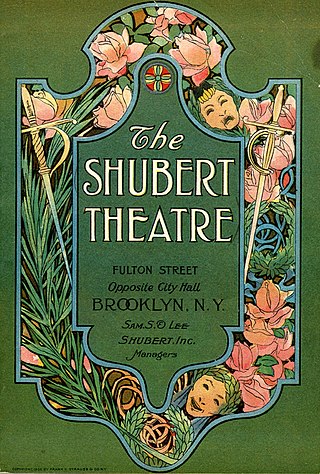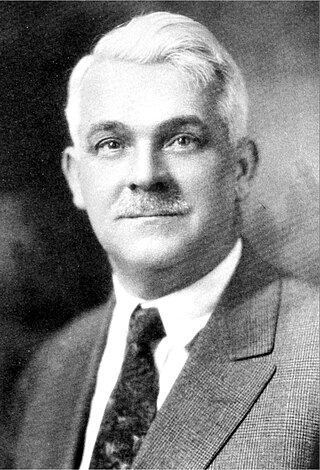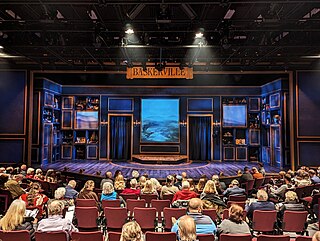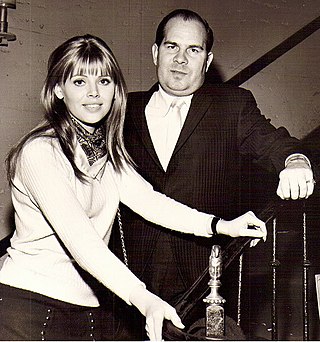
The Shubert Organization is a theatrical producing organization and a major owner of theatres based in Manhattan, New York City. It was founded by the three Shubert brothers in the late 19th century. They steadily expanded, owning many theaters in New York and across the United States. Since then it has gone through changes of ownership, but it is still a major theater chain.

Thomas White Lamb was a Scottish-born, American architect. He was one of the foremost designers of theaters and cinemas in the 20th century.

The Trocadero Theatre is a historic theater located in Chinatown in Philadelphia, Pennsylvania. It offered musical comedies, vaudeville, opera, and burlesque. The Trocadero Theatre was refurbished for use as an art house cinema and fine arts theatre in 1970s, and by the 1990s had become an iconic venue for rock and punk concerts.
Harry Steppe, March 16, 1888 – November 22, 1934 was a Russian Jewish-American actor, musical comedy performer, headliner comedian, writer, librettist, director and producer, who toured North America working in Vaudeville and Burlesque. Steppe performed at several well-known theaters on the Columbia, Mutual and Orpheum circuits. Steppe was one of Bud Abbott's first partners.

Everyman Theatre is a regional theatre with a professional repertory company of artists in downtown Baltimore, Maryland. Everyman's mission is to bring accessible and affordable theatre to the city of Baltimore. Everyman Theatre is located in downtown Baltimore in the Bromo Arts and Entertainment District.

John Adolph Emil Eberson was an Austrian-American architect best known for the development and promotion of movie palace designs in the atmospheric theatre style. He designed over 500 theatres in his lifetime, earning the nickname "Opera House John". His most notable surviving theatres in the United States include the Tampa Theatre (1926), Palace Theatre (1928), Majestic Theatre (1929), Akron Civic Theatre (1929) and Paramount Theatre (1929). Remaining international examples in the atmospheric style include both the Capitol Theatre (1928) and State Theatre (1929) in Sydney, Australia, The Forum, the Lewis J. Warner Memorial Theater (1932) at Worcester Academy in Worcester, Massachusetts and Le Grand Rex.

The Hudson Theatre is a Broadway theater at 139–141 West 44th Street, between Seventh Avenue and Sixth Avenue, in the Theater District of Midtown Manhattan in New York City. One of the oldest surviving Broadway venues, the Hudson was built from 1902 to 1903. The exterior was designed by J. B. McElfatrick & Son, while Israels & Harder oversaw the completion of the interior. The theater has 970 seats across three levels. Both the exterior and interior of the theater are New York City designated landmarks, and the theater is on the National Register of Historic Places.

The Riley Center, also known as the Grand Opera House and formally as the Mississippi State University Riley Center for Education and Performing Arts, is a performing arts and conference center in Meridian, Mississippi. It was added to the National Register of Historic Places in 1972.

The Majestic Theatre is a performing arts theater in the City Center District of Downtown Dallas. It is the last remnant of Theater Row, the city's historic entertainment center on Elm Street, and is a contributing property in the Harwood Street Historic District. The structure is a Dallas Landmark and is listed on the National Register of Historic Places.

The Harlem Alhambra was a theater in Harlem, New York, built in 1905, that began as a vaudeville venue. The building still stands at 2108-2118 Adam Clayton Powell Jr. Boulevard at the South-West corner of 126th Street. The architect was John Bailey McElfatrick (1829–1906) who, based in Manhattan, founded the architectural firm John B. McElfatrick & Son – builder of 100 theaters. Construction on the structure commenced late 1902 by its original owner, Harlem Auditorium Amusement Company.

The Park Theatre (est.1879) was a playhouse in Boston, Massachusetts, in the late 19th and early 20th centuries. It later became the State cinema. Located on Washington Street, near Boylston Street, the building existed until 1990.
The Gaiety Theatre (1908–1949) or Gayety Theatre of Boston, Massachusetts, was located at no.661 Washington Street near Boylston Street in today's Boston Theater District. It featured burlesque, vaudeville and cinema. Performers included Clark and McCullough, Solly Ward, and Lena Daley; producers included Charles H. Waldron, Earl Carroll, and E.M. Loew. In 1949 it became the "Publix Theatre." The building existed until its razing in 2005.

Leroy Charles Griffith is an American theater and nightclub proprietor, former Broadway theater producer, and film producer. He has owned, leased, or operated more than 70 adult entertainment theaters across the United States, dating from the burlesque era of the 1950s to present day nightclubs. During burlesque's heyday, he was a prolific producer of live stage shows featuring showgirls, strippers, comedians, and other stars of the era.

The Columbia Amusement Company, also called the Columbia Wheel or the Eastern Burlesque Wheel, was a show business organization that produced burlesque shows in the United States between 1902 and 1927. Each year, about four dozen Columbia burlesque companies would travel in succession round a "wheel" of theaters, ensuring steady employment for performers and a steady supply of new shows for participating theaters. For much of its history the Columbia Wheel promoted relatively "clean" variety shows featuring comedians and pretty girls. Eventually the wheel was forced out of business due to changing tastes and competition from its one-time subsidiary and eventual rival, the Mutual Burlesque Association, as well as cinemas and cruder stock burlesque companies.
Ernest C. Bairstow (1876–1962) was an English-born American architectural sculptor noted for work on buildings in Washington, D.C., including the Lincoln Memorial.

The Columbia Theatre was an American burlesque theater on Seventh Avenue at the north end of Times Square in Midtown Manhattan, New York City. Operated by the Columbia Amusement Company between 1910 and 1927, it specialized in "clean", family-oriented burlesque, similar to vaudeville. Many stars of the legitimate theater or of films were discovered at the Columbia. With loss of audiences to cinema and stock burlesque, the owners began to offer slightly more risqué material from 1925. The theater was closed in 1927, renovated and reopened in 1930 as a cinema called the Mayfair Theatre. It went through various subsequent changes and was later renamed the DeMille Theatre. Nothing is left of the theater.

Harlem Opera House was a US opera house located at 211 West 125th Street, in the Harlem neighborhood of Manhattan in New York City. Designed by architect John B. McElfatrick, it was built in 1889 by Oscar Hammerstein; it was his first theater in the city.
Tignal Franklin "Frank" Cox (1854–1940) was an American artist and theater architect. He worked as a scenic artist, decorator, builder, architect, and developer.
John Bailey McElfatrick (1828–1906) was an architect known for his design of theaters in the United States and Canada. He eventually went into practice with his sons William H. McElfatrick and John Morgan McElfatrick (1853-1891) in the firm J. B. McElfatrick & Sons.
The Mutual Burlesque Association, also called the Mutual Wheel or the MBA, was an American burlesque circuit active from 1922 until 1931. Controlled by Isidore Herk, it quickly replaced its parent company and competitor, the Columbia Amusement Company, as the preeminent burlesque circuit during the Roaring Twenties. Comedians Bud Abbott, Lou Costello, Harry Steppe, Joe Penner, Billy Gilbert, Rags Ragland, and Billy Hagan, as well as stripteasers Ann Corio, Hinda Wausau, Gypsy Rose Lee, and Carrie Finnell, performed in Mutual shows. Mae West appeared in Mutual shows from 1922 to 1925. Mutual collapsed during the Great Depression.

















